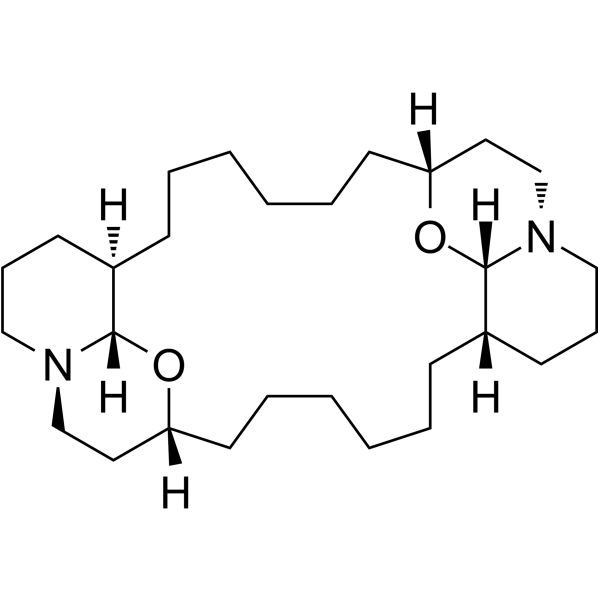Xestospongin C

Xestospongin C structure
|
Common Name | Xestospongin C | ||
|---|---|---|---|---|
| CAS Number | 88903-69-9 | Molecular Weight | 446.709 | |
| Density | 1.1±0.1 g/cm3 | Boiling Point | 564.7±35.0 °C at 760 mmHg | |
| Molecular Formula | C28H50N2O2 | Melting Point | N/A | |
| MSDS | Chinese USA | Flash Point | 145.6±23.2 °C | |
|
mGluR5 in the nucleus accumbens shell regulates morphine-associated contextual memory through reactive oxygen species signaling.
Addict. Biol. 20 , 927-40, (2015) Emerging evidence indicates that metabotropic glutamate receptor 5 (mGluR5) critically modulates drug and drug-related behaviors. However, the role of mGluR5 in the opiate-induced contextual memory remains unclear. Here, we found that microinfusion of the mGl... |
|
|
Aβ and NMDAR activation cause mitochondrial dysfunction involving ER calcium release.
Neurobiol. Aging 36(2) , 680-92, (2015) Early cognitive deficits in Alzheimer's disease (AD) seem to be correlated to dysregulation of glutamate receptors evoked by amyloid-beta (Aβ) peptide. Aβ interference with the activity of N-methyl-d-aspartate receptors (NMDARs) may be a relevant factor for A... |
|
|
Intracellular Ca(2+) release from endoplasmic reticulum regulates slow wave currents and pacemaker activity of interstitial cells of Cajal.
Am. J. Physiol. Cell Physiol. 308 , C608-20, (2015) Interstitial cells of Cajal (ICC) provide pacemaker activity in gastrointestinal muscles that underlies segmental and peristaltic contractions. ICC generate electrical slow waves that are due to large-amplitude inward currents resulting from anoctamin 1 (ANO1... |
|
|
Protection of differentiated neuronal NG108-15 cells from P2X7 receptor-mediated toxicity by taurine.
Pharmacol. Rep. 66(4) , 576-84, (2014) Strong P2X7 receptor (P2X7R) activation causes Ca(2+) overload and consequent cell death. We previously showed that depletion of Ca(2+) stores and endoplasmic reticulum (ER) stress in differentiated NG108-15 neuronal cells contributed to P2X7R-mediated cytoto... |
|
|
Arachidonate-regulated Ca(2+) influx in human airway smooth muscle.
Am. J. Respir. Cell. Mol. Biol. 51(1) , 68-76, (2014) Plasma membrane Ca(2+) influx, especially store-operated Ca(2+) entry triggered by sarcoplasmic reticulum (SR) Ca(2+) release, is a key component of intracellular calcium concentration ([Ca(2+)]i) regulation in airway smooth muscle (ASM). Agonist-induced Ca(2... |
|
|
Orexin A regulates plasma insulin and leptin levels in a time-dependent manner following a glucose load in mice.
Diabetologia 58 , 1542-50, (2015) Orexin A (OXA) is a neuropeptide implicated in the regulation of arousal status and energy metabolism. Orexin receptors are expressed not only in the central nervous system but also in the pancreas and adipose tissue. However, little is known about the physio... |
|
|
PC-PLC/sphingomyelin synthase activity plays a central role in the development of myogenic tone in murine resistance arteries.
Am. J. Physiol. Heart Circ. Physiol. 308 , H1517-24, (2015) Myogenic tone is an intrinsic property of the vasculature that contributes to blood pressure control and tissue perfusion. Earlier investigations assigned a key role in myogenic tone to phospholipase C (PLC) and its products, inositol 1,4,5-trisphosphate (IP3... |
|
|
Activation of a TRP-like channel and intracellular Ca2+ dynamics during phospholipase-C-mediated cell death.
J. Cell Sci. 127(Pt 17) , 3817-29, (2014) The model organism Neurospora crassa undergoes programmed cell death when exposed to staurosporine. Here, we show that staurosporine causes defined changes in cytosolic free Ca(2+) ([Ca(2+)]c) dynamics and a distinct Ca(2+) signature that involves Ca(2+) infl... |
|
|
Induction of autophagy by valproic acid enhanced lymphoma cell chemosensitivity through HDAC-independent and IP3-mediated PRKAA activation.
Autophagy 11 , 2160-71, (2016) Autophagy is closely related to tumor cell sensitivity to anticancer drugs. The HDAC (histone deacetylase) inhibitor valproic acid (VPA) interacted synergistically with chemotherapeutic agents to trigger lymphoma cell autophagy, which resulted from activation... |
|
|
Xestospongin C, a selective and membrane-permeable inhibitor of IP(3) receptor, attenuates the positive inotropic effect of alpha-adrenergic stimulation in guinea-pig papillary muscle.
Br. J. Pharmacol. 130 , 650, (2000) We evaluated the role of the inositol 1,4,5-triphosphate (IP(3)) receptor-mediated Ca(2+) release on the positive inotropic effects of alpha-adrenergic stimulation using a novel, potent, selective membrane-permeable blocker of IP(3) receptor, xestospongin C. ... |